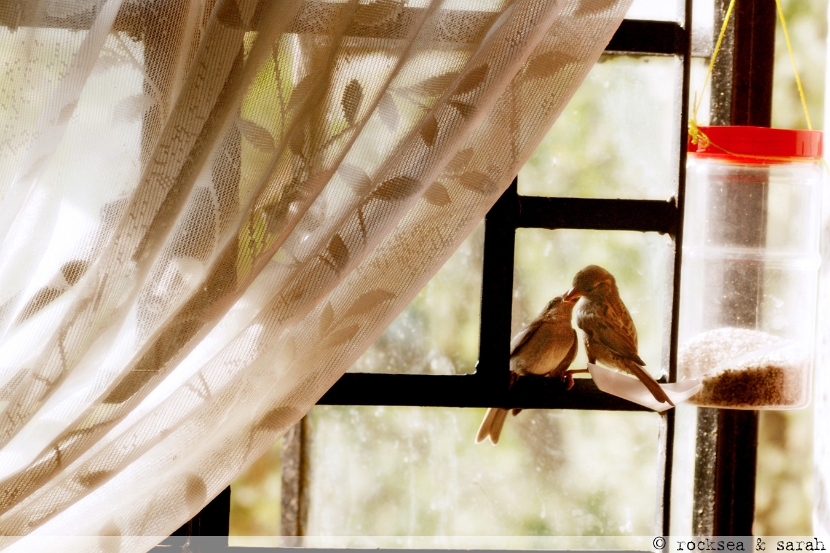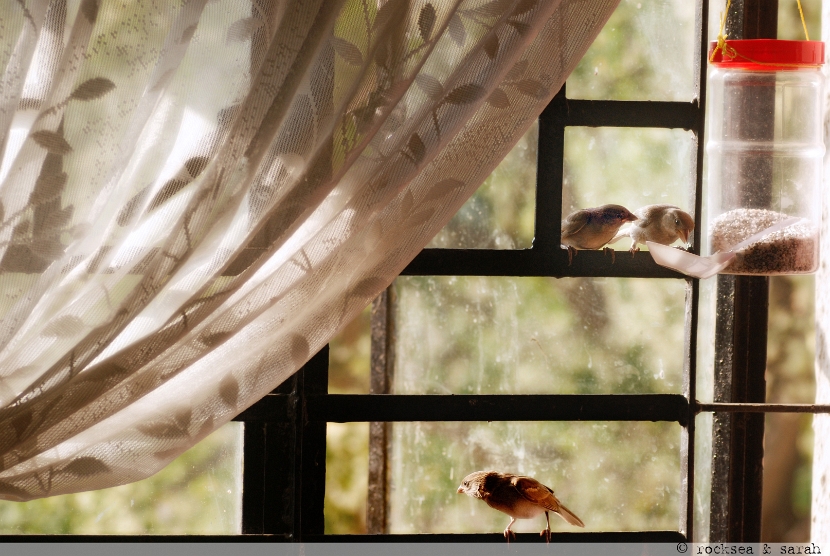re-friend a sparrow
It’s world sparrow day today, 20th March. Sparrows have been those winged companions of humans for a long time. Over the recent years there has been a sharp decline in the sparrow sightings though- probably owing to the mindless advancement of their human companions?
Here are some images from our kitchen window, and ideas on how you can re-friend a sparrow.

A female house sparrow feeding a juvenile.

The male house sparrow below is acting as a sentinel (watch), while the others are enjoying the bird feed.
For the bird feed you can simply recycle a plastic container and a spoon. The size of the hole and the shape of the spoon regulates the flow of the grains from the container. The bird feed in the images above was made by sarah.
Male house sparrows have a black throat patch, which is known as a badge. Studies show that males with larger badge sizes are dominant among their flocks. Other than acting as a status signal of dominance, the badge size also favour the male sparrows in obtaining a mate.
Species: Passer domesticus Family: passeridae
Common Name: House Sparrow
Location: @ home, Pashan, Pune
Reference:
- Møller AP (1987) Variation in badge size in male house sparrows Passer domesticus: evidence for status signalling. Animal Behaviour 35 (6):1637-1644
- Møller AP (1988) Badge size in the house sparrow Passer domesticus. Behavioral Ecology and Sociobiology 22 (5):373-378
 Roxy Mathew Koll is a Climate Scientist at the Indian Institute of Tropical Meteorology. He also dons the role of an amateur naturalist, writer, web designer, photographer, and publisher—based on demand.
Roxy Mathew Koll is a Climate Scientist at the Indian Institute of Tropical Meteorology. He also dons the role of an amateur naturalist, writer, web designer, photographer, and publisher—based on demand. Juby Aleyas Koll, also know as Sarah, is the author and publisher of the book and website Sarah’s Hand Embroidery Tutorials. She has been researching and tutoring hand embroidery for over a decade, making it accessible to everyone around the globe.
Juby Aleyas Koll, also know as Sarah, is the author and publisher of the book and website Sarah’s Hand Embroidery Tutorials. She has been researching and tutoring hand embroidery for over a decade, making it accessible to everyone around the globe.
A wonderful post and heart touching one. Loved the pic when female sparrow feeds the juvenile. It’s my first visit to your blog but it’s simply beautiful 🙂 Keep up the good work.
Hi!
Nice Blog!
Can you share how did you make that feeding container for the sparrows?
KR,
Tejashree
Dear Tejashree,
I will try my best to explain the procedure to make a bird feed. I will describe how I made the bird feeder shown in the photo.
Take a plastic jar. The one shown in the picture was a cheesling jar. Now, just about 2 inches above the base of the jar, make a one inch slit. Now, on the opposite side of this slit, make another slit about 3 inches above the base. Now, take a plastic spoon with a groove running through the center. Insert the handle of the spoon from the first slit and bring it out from the second one. Now, you can secure the spoon by applying a tape on the second slit with the spoon. Now, pour the grains into the jar and close the lid. The grains should not be more than the size of a rice. Try to use broken rice if possible. Check if the grains fall through the first slit into the mouth of spoon when tapped. If it does not pass through easily, try to make the slit a bit wider, just enough for the grains to pass through. Once this is done, you can hang the jar on a window and wait for the sparrows to come.
Make sure the jar is transparent, so that the sparrows can spot the grains. You can use soft drink bottles to make a feeder. Once the sparrow starts feeding, the spoon will get automatically filled as the bird eats from it.
Hope this helps! Let us know if it worked. 🙂
Very nice bird feed indeed! I hope you don’t mind sharing the link in my FB page! 🙂
Yes, please! We have been using these bird feeds for the last 5+ years and we have daily visitors 🙂